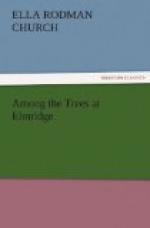“Where does slippery elm come from?” asked Clara.
“From another American species, dear, which is very much like the white elm that we have been considering. The slippery elm is a smaller tree, does not droop so much, and the trunk is smoother and darker. The leaves are thicker and very rough on the upper side. The inner bark contains a great deal of mucilage—that, I suppose, is the reason for its being called ’slippery’—and it has been extensively used as a medicine. The wood is very strong and preferred to that of the white elm for building-purposes, although the latter is considered the best native wood for hubs of wheels. There is a great elm tree on Boston Common which is over two hundred years old, and another in Cambridge called the ‘Washington Elm,’ because near it or beneath its shade General Washington is said to have first drawn his sword on taking command of the American army. In 1744 the celebrated George Whitefield preached beneath this tree.”
“I’m glad we have elm trees here,” said Malcolm, “though I s’pose nobody ever did anything in particular under ours.”
“You mean,” replied his governess, laughing, “that they are not historical trees; but they are certainly very fine ones. There is another species of elm, the English, which is often seen in this country too. It is a very large and stately tree, but not so graceful as our own elm. It is distinguished from the American elm by its bark, which is darker and much more broken; by having one principal stem, which soars upward to a great height; and by its branches, which are thrown out more boldly and abruptly and at a larger angle. Its limbs stretch out horizontally or tend upward with an appearance of strength to the very extremity; in the American elm they are almost universally drooping at the end. Its leaves are closer, smaller, more numerous and of a darker color. In England this tree is a great favorite with those black and solemn birds the rooks. The poet Hood writes of it as
“’The tall,
abounding elm that grows
In hedgerows
up and down,
In field and forest,
copse and park,
And in the
peopled town,
With colonies of noisy
rooks
That nestle
on its crown.’
“Some of these English elms are very ancient and of an immense size; one of them, known as the ‘Chequer Elm,’ measures thirty-one feet around the trunk, of which only the shell is left. It was planted seven hundred years ago. The Chipstead Elm is fifteen feet around; the Crawley Elm, thirty-five. A writer says, ’The ample branches of the Crawley Elm shelter Mayday gambols while troops of rustics celebrate the opening of green leaves and flowers. Yet not alone beneath its shade, but within the capacious hollow which time has wrought in the old tree, young children with their posies and weak and aged people find shelter during the rustic fetes.’”
“Does that mean that people can sit inside the tree?” asked Clara. “I wish we had one to play house in where Hemlock Lodge is.”




